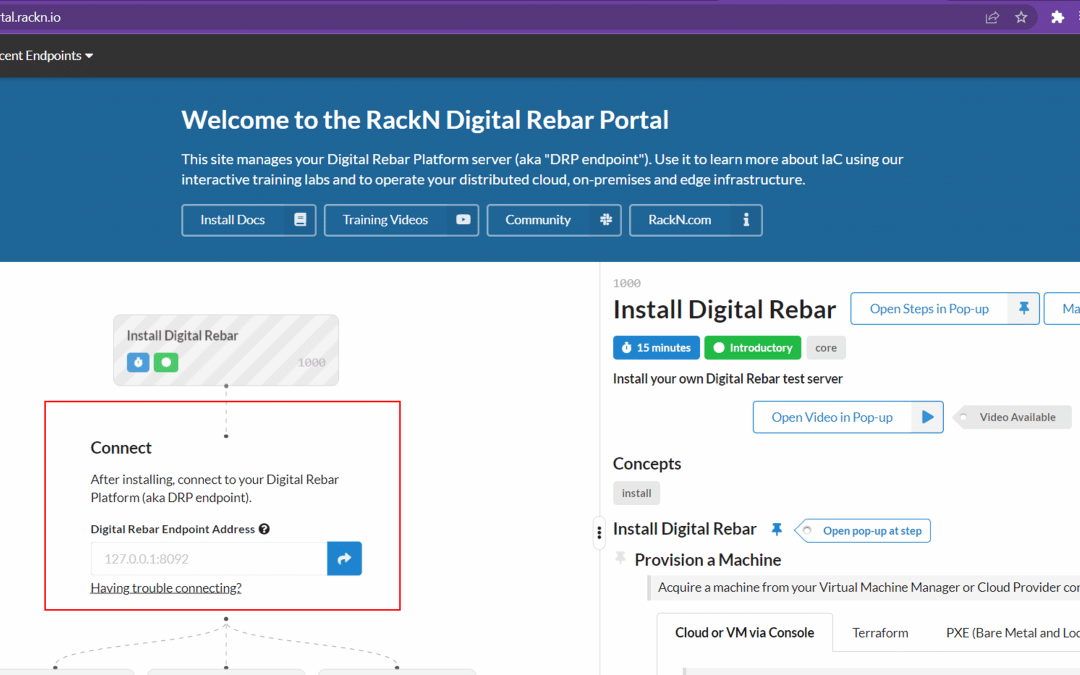If you’re a traditional admin you probably know that you need to learn how to manage automation, and that means learning about Infrastructure as Code (IaC). But where should you even start? RackN has a platform that automates IaC, so maybe doing their Digital Rebar trial would be a good place to start.
This blog post walks through connecting to a hosted RackN Digital Rebar trial and creating a cluster of machines.
Full disclosure: RackN is one of my clients. However, they didn’t pay me to write this post, nor did they get an advanced review of this post.
Setup/Installation
The first step to trialing the Digital Rebar Platform (DRP) is to install the Digital Rebar software. To do that, you need a Linux server. It can be a physical or virtual (including public cloud) server. The Linux flavor isn’t specified, but it needs to have 4+GB RAM and ports 22, 8090-8092 open.
I don’t have a lab anymore, so I don’t just have a Linux server sitting around. Lucky for me, RackN has a hosted trial. You must fill out a form to request access to a RackN hosted trial. If you meet the requirements, they will provide you access to a hosted server. Luckily, they are one of my clients (see disclosure above), so they sent me an invite.
Using the Digital Rebar Portal
If your request is accepted, RackN will create a server for your trial that has Digital Rebar already installed on a server - this will be your endpoint. The endpoint needs to connect to the Digital Rebar Portal - that’s where all the magic happens.
If you’re using the hosted trial, you’ll receive an email from them that contains your username, password, and endpoint address. You’ll need these to log into the DRP Portal – portal.rackn.io
Before you log in, this is the screen you’ll see on the Portal. If you are building your server, you’ll find helpful install tips on the right side of the page (you can adjust the size of the helpful tips section).
You can also log in to the Digital Rebar Portal directly from the email you’re sent. Just click on the Endpoint Address and you’ll end up on this license page:
Once you’ve authenticated, this is what you’ll see:
Using the Labs as a trial guide
I used the built-in Labs for my trial guide. Choose the green Labs button at the top of the Portal screen to go the Digital Rebar Labs page. This is what you’ll see:
If you click on a box, a lab page will open. Any greyed-out boxes are labs that have been completed. The Leveraging Labs box will open a Lab that explains how to use the labs. But let’s start with the Lab Manage Groups of Machines using Clusters.
Digital Rebar Platform resources
I already have an endpoint machine, and I have a context broker and pool broker. Next I want to create a cluster of machines to work with. To understand what this all means, let’s define DRP resources:
- Machines: This is a list of the actual machines (physical or virtual) that are available to be used. DRP is an infrastructure as code platform, so this is obviously a core building block. Here’s my machine list at this point:
- Resource Brokers: These accept requests to allocate or release machines. A context broker and pool broker were created as part of the hosted trial.
- Clusters: Clusters manage a collection of machines. They are used to coordinate operations over those machines.
- Pools: Pools have three basic functions: grouping machines, machine allocation, and machine transitions between pools
- Racks: Machines can also be organized by racks.
Let’s create a Cluster!
Creating a cluster is easy. I clicked on Clusters in the Resources column, then clicked Add. I followed the Guided Lab to name it and kept the defaults.
You can click the Activity tab to see the behind-the-scenes action of what it takes to create the cluster. You can also click on Resources -> Resource Brokers -> context-broker -> Activity to see what actions were taken by the Context Broker to build machines. This is IaC in action – and Digital Rebar is doing all the work required to build a cloud server. All I had to do was ask it to build a 3-node cluster.
Now if I check back in Resources — > Machines, I can see the new lab machines that were created by the Create Cluster command.
What should I do next?
Now that I’ve created 3 machines, what should I do next? In the real world I’d probably set up SSH access to the machines and figure out how to turn the machines into servers that worked for me (virtualization, specific applications, etc.).
The Start Remote Access Lab will walk through setting up SSH. The Create Your Own Blueprint to Respond to Triggers Lab walks through creating a Blueprint. Blueprints automate Work Order creation. Just look at the Catalog, there are so many IaC items already configured for you!
Real Talk
IaC is an important element of Digital Transformation. Everything that can be treated as code, needs to be run as code. And that includes everything from cloud servers to VMs to bare metal servers. I used to write kickstart and jumpstart scripts, and the evolution from those days to this is just amazing!
This was a short post to give you a glimpse into one of the tools that can help you modernize your environment to run as code. How are you doing this in your environment?

